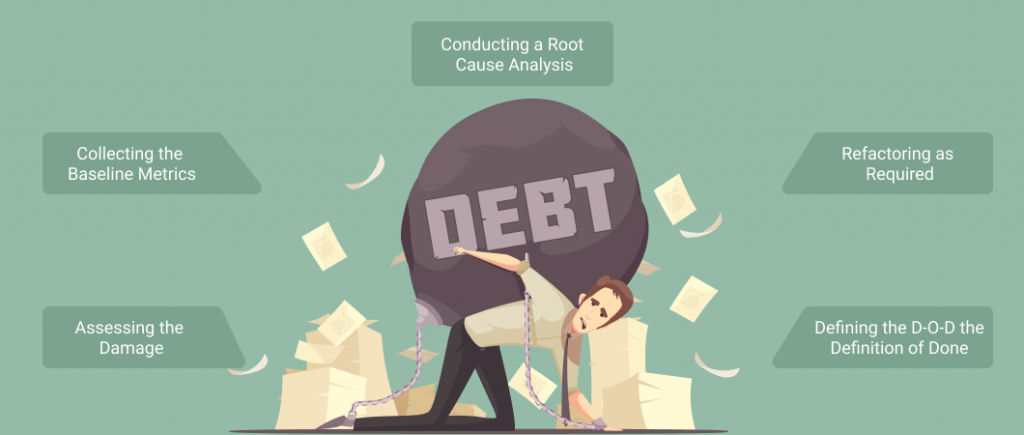Last updated on October 21st, 2024
When it comes to software architecture, a visionary design has many benefits. It actually paves the way for a product that can be more agile and accommodative of the changes-to-come in the future. This could, even, reduce technical debt.
Technical debt can consume your time and efforts in an effort to fix the unfixed. And a key issue is trying to figure out the probable causes. Is it an unclean code that was built without a vision in mind? Or an unrealistic approach to design? A lot of productive time, energy, and, even budgets of software development teams suffer in managing carried over debt.
Clearly, companies can reduce technical debt if they are aware of the looming threat or if they anticipate the possibility that they may have to deal with ‘consequences’ in the future. The question is, are you really prepared with strategies in place to deal with technical debt before it spirals out of control!
The first step to creating a strategy is to know the size of the problem. And that starts with auditing your technical debt.
Here is a 5-step approach that you can adopt to audit your technical debt and curb further damages.
1. Assessing the damage
Understanding the severity of the problem is the first step towards fixing it. Identifying the scale of the eventual impact on the performance of the product and the customer experience is key. This is not just about what has already happened. It’s a considered view of what could happen should you choose to live with the technical debt. You must try to draw conclusions about how the technical debt will impact your product’s performance, scalability, security, and usability? Will this curb your technical agility? Will it hamper your ability to adopt new technology or deliver a better customer experience? Is there any customer feedback from previous product versions that offers these clues?
The task of going back to the drawing board and, probably, having to join these historical dots might seem enormous however it is the essential first step in fixing your technical debt.
2. Collecting the baseline metrics
It’s easier to get your debt under control when you set up baseline parameters or metrics. That puts things into perspective and gives a definitive direction for further analysis, evaluation, and solution. You can use the baseline metrics to identify and track the measure of the impact of the technical debt at any given point of time. For instance, you could track the actual number of days taken to fix the code to help know the trajectory of the debt. This analysis could be intelligently extended to the future too. If a vision exists for the product, looking at the likely impact of the carried over technical debt in the context of that vision could help show just how important (or otherwise) it may be to fix that debt. Some of these assessments are quite objective (like days needed to fix) and others, objective. A smart mix of measures makes for the best judgments.
3. Conducting a root cause analysis
There may be many sources that may have given rise to the technical debt. While applications and architectures show the visible impact of the debt, the reasons could vary. It could be the lack of innovation combined with the lack of governance or simply a lack of discipline around following coding standards and practices. Poor testing standards or practices may be to blame. It could also be the code that was built in a hurry, in a bid to reduce time-to-market with some intentional shortcuts that lacked functionality. It could be the architecture, documentation or infrastructure. Duplication, the complexity of coding and functions could be the other causes. Conducting a root cause analysis will shine a light on what must change. As much as finding the technical glitches is important, it is also very crucial to get all the technical and non-technical people on to the same page. Involving stakeholders and enabling each one to come up with measures to avoid the recurrence of problems can help.
4. Refactoring as required
Refactoring may be the most important thing you can do to reduce your technical debt. Refactoring right from the beginning may seem strange; however, it could play a significant role in the strategy. Refactoring can mean breaking in the pathways of the system, changing the functionality, the logical connections that establish the functionality and the ones that are not connected too. Refactoring comes with the obligation to undertake extensive testing.
5. Defining the D-O-D the definition of done
The definition of “done” can vary in different scenarios. What is “undone” in technical debt may or may not be fully “done” while working towards the solution. “Done” can only be defined by the team. The team’s ownership values and enforcement of what “done” mean to each one of them is key. It is about taking ownership down to the individual level. Professional oversight is necessary to ensure that any re-configured product is really ready for a release with manageable baggage of technical debt. The definition of “done” can evolve at every stage of coding or building the product, so that the oversight can reduce technical debt in the first place, while also bringing everyone on the same page.
Conclusion
The solution to creating manageable technical debt may be hiding in plain sight at the beginning – where the software architecture is being defined. Factors such as expectations, milestones, project trajectory, communication between stakeholders, user expectations, concerns of the developers, marketing challenges, and more come together to determine the enormity of technical debt. Clearly, technical debt is unavoidable and, indeed, inevitable. The key is knowing the size of the problem you are choosing to live with and having a clear vision to fix it going forward.



